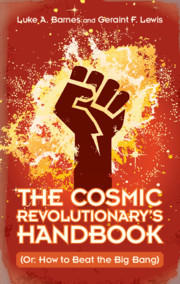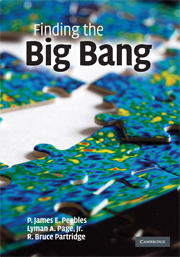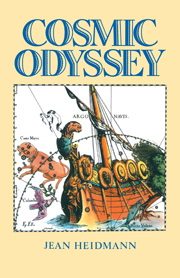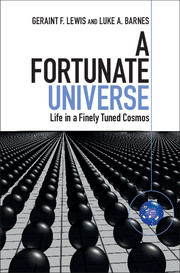The Cosmic Revolutionary's Handbook
(Or: How to Beat the Big Bang)
$25.95 (T)
- Authors:
- Luke A. Barnes, Western Sydney University
- Geraint F. Lewis, Sydney Institute for Astronomy
- Date Published: March 2020
- availability: In stock
- format: Hardback
- isbn: 9781108486705
$
25.95
(T)
Hardback
Other available formats:
Paperback, eBook
Looking for an examination copy?
If you are interested in the title for your course we can consider offering an examination copy. To register your interest please contact [email protected] providing details of the course you are teaching.
-
Free yourself from cosmological tyranny! Everything started in a Big Bang? Invisible dark matter? Black holes? Why accept such a weird cosmos? For all those who wonder about this bizarre universe, and those who want to overthrow the Big Bang, this handbook gives you 'just the facts': the observations that have shaped these ideas and theories. While the Big Bang holds the attention of scientists, it isn't perfect. The authors pull back the curtains, and show how cosmology really works. With this, you will know your enemy, cosmic revolutionary - arm yourself for the scientific arena where ideas must fight for survival! This uniquely-framed tour of modern cosmology gives a deeper understanding of the inner workings of this fascinating field. The portrait painted is realistic and raw, not idealized and airbrushed - it is science in all its messy detail, which doesn't pretend to have all the answers.
Read more- Presents a unique angle on cosmology - a toolkit for bringing down established cosmological theories, for would-be revolutionaries
- Addresses alternative theories to the big bang and the latest observational evidence that needs to be accounted for
- An accessible, non-mathematical introduction as to why cosmologists believe the things they do, and how scientific theories get accepted or discarded
Awards
- Choice Outstanding Academic Title 2020, Choice Reviews.
Reviews & endorsements
'Overthrowing all of modern cosmology isn’t easy, but it could happen. Maybe you will be the one to do it! If you’re up for the challenge, Luke A. Barnes and Geraint F. Lewis tell you exactly what you have to accomplish. Even if you don’t topple the stodgy edifice of modern science, you’ll certainly learn some exciting things about the universe along the way.' Sean Carroll, author of Something Deeply Hidden: Quantum Worlds and the Emergence of Spacetime
See more reviews'If you are looking for a fun rendezvous with the universe, this is the book for you! Barnes and Lewis help you understand the basics of cosmology with simplicity and clarity - quite a feat given the complexity of our universe.' Priyamvada Natarajan, author of Mapping the Heavens: The Radical Scientific Ideas that Reveal the Cosmos
'… a great starting point for budding astronomers or cosmologists who want to be able to 'debunk' would-be revolutionaries - or answer the 'but how do we know …' they're likely to get asked.' Chris North, BBC Sky at Night Magazine
'A must-read for anyone interested in better understanding why cosmologists believe all those very strange things about the Universe. Mind you, new Galileo, you will still need a degree in physics and professional research training if you want to overthrow the Big Bang model, but this book might very well be the first step towards your goal.' Sunny Vagnozzi, Nature Astronomy
‘The general educated public has heard about many key terms of modern science: 'evolution,' 'virus,' 'quantum theory,' and the 'big bang,' for example. But the framework and methodology of science are barely understood by most … Here, Barnes (Western Sydney Univ.) and Lewis (Sydney Institute for Astronomy) inform the general reader about many fascinating aspects of astronomy, astrophysics, and cosmology. The book is full of scientific facts and clarifying figures. More importantly, it clarifies the routes that lead to major scientific results … Readers will gain a more than nodding acquaintance with the basics of astrophysics, including magnetic monopoles, dark matter, the inflationary model, and related key concepts … books like this will inform and educate those who respect science and are willing to learn about good science and how it is done. This should be required reading for all college students, regardless of their major.’ V. V. Raman, Choice
‘The book is well written and includes a bit more ‘how’ (do we know) in addition to the ‘what’ of the standard model of cosmology … I enjoyed reading this book; it’s a breezy but careful introduction to where we are in our understanding of the Universe and how we got there.’ Phillip Helbig, The Observatory
Customer reviews
19th Mar 2024 by UName-1063309
Very informative, interesting, and clear. It really stimulated my thinking - so I'm including these thoughts not just about the book but also about videos by the authors. What is cosmological redshift? Alas Lewis & Barnes (https://www.youtube.com/watch?v=cHwBG82mvDc) Doctors, I need help in understanding your book! I can't be comprehending it properly because, to me, there seems to be a glaring contradiction about gravitational redshift in chapter 3. In the last paragraph on p. 66, you write stars (cannot be packed tightly enough) for gravitational redshift by the galaxy itself to explain its redshift. So you answer no to the question, Could the redshift of distant galaxies be due to gravitational redshift? Only two pages earlier, you wrote, Einstein tells us that ... spacetime curvature is gravity. This appears to answer Yes, the redshift of distant galaxies could indeed be due to gravitational redshift. My reasoning - since spacetime and gravity always exist at every point between us and the distant galaxy, the gravitation of the galaxy itself is not solely responsible for the gravitational redshift. The shift is also due to every single spacetime coordinate between us and any galaxy - the further away a galaxy is, the more redshifting spacetime and gravity its visible light and other electromagnetic radiations must traverse. If pp. 66 and 64 really are a contradiction, they wouldn't just be yours but would reflect contradictory (self-destructive) thinking about redshift, and the Big Bang which redshift is so important to, among all astronomers for the better part of a century. Einstein himself couldn't agree with my reasoning because my thoughts could be dressed up as quantum entanglement acting macroscopically and uniting everything in space and time with everything else ... he definitely didn't like spooky action at a distance. On the bright side, this exotic reasoning I write about does combine elements from General Relativity and quantum mechanics, meaning the conclusion might end up being essential to a future theory of quantum gravity. ------------------------------------------------------------------------------------------- Are worm holes and warp drives possible? Alas Lewis & Barnes (https://www.youtube.com/watch?v=_0zH7o3EEaI) In 1924 the scientist Wolfgang Pauli was the first to propose a doubling of electron states due to a two-valued non-classical hidden rotation. Extending the ideas of “doubling”, “two-valued” and “hidden rotation” to the Mobius strip being a basic, fundamental unit of reality it can be seen that Pauli’s proposal has an analogy to this comment. The doubled Mobius strips – each strip is only two dimensional (2D) – could possibly be produced by the two-valued binary-digit system used in electronics traversing a wormhole, or shortcut between folds in space and time, designed by humans of the far future. These Mobius strips might then be used to form the universe, if a recent paper in ”Physical Review Letters” is correct when it says that in a holographic universe, all of the information in the universe is contained in 2D packages trillions of times smaller than an atom. (Niayesh Afshordi, Claudio Corianò, Luigi Delle Rose, Elizabeth Gould, and Kostas Skenderis, “From Planck Data to Planck Era: Observational Tests of Holographic Cosmology”, Phys. Rev. Lett. 118, 041301 (2017), Published 27 January 2017, https://journals.aps.org/prl/abstract/10.1103/PhysRevLett.118.041301) (Just as the interference between two laser beams produces a three-dimensional holographic image, holographic would also have the accepted cosmological meaning of the entire universe being seen as two-dimensional information – from Mobius strips, according to this article - projected into the third and fourth dimensions we’re familiar with.) The binary digits give that cosmos Artificial Intelligence (AI), and two united Mobius strips create a three-dimensional figure-8 Klein bottle (Polthier, Konrad, Imaging maths - Inside the Klein bottle, http://plus.maths.org/content/os/issue26/features/mathart/index) that acts as a building block of space, time, forces’ bosons and matter’s fermions. This creates a supersymmetry (linkage) between fermions and bosons. Also - trillions of Mobius strips could form a photon and trillions of more complex figure-8 Klein bottles could form a more complex graviton (suggesting union of electromagnetism and gravitation), and electromagnetism's photons interact with gravitation's gravitons via vector-tensor-scalar geometry to form forces’ bosons and matter’s fermions (see INTERSTELLAR, INTERGALACTIC AND TIME TRAVEL PLUS SIMPLY-CONNECTED AND NONORIENTABLE TOPOLOGY). The bottles possess a hidden rotation, now identified as adaptive Wick rotation, which gives a fourth dimension to space-time. This Wick rotation is consistent with Special Relativity’s slowing of time (a.k.a. time dilation) because - The electromagnetic and gravitational waves composing space-time rotate in a circle. The waves rotate through the vertical y-axis that is home to so-called Dark Matter and the non-expanding universe’s Dark Energy, and back to the horizontal x-axis' space-time. Since quantum mechanics says particles can be in two or more places at once, the photons and gravitons which make up the waves in space-time can be on the x- and y-axes simultaneously and thus interfere with themselves, causing time to slow down. The relation of space (to be precise, spacetime) and matter was spoken of by French philosopher/mathematician/scientist Rene Descartes (1596-1650). Today I wish to discuss how the space-matter relation fits in with my idea that it's time for a new scientific paradigm. The equivalence of space and matter is something Albert Einstein also believed in. He wrote a paper in 1919 which asked if gravitation plays a role in the composition of elementary particles of matter. (Albert Einstein, “Spielen Gravitationfelder in Aufbau der Elementarteilchen eine Wesentliche Rolle?” [Do gravitational fields play an essential role in the structure of elementary particles?], Sitzungsberichte der Preussischen Akademie der Wissenschaften, [Math. Phys.], 349-356, Berlin, 1919) This present article agrees when, in Vector-Tensor-Scalar Geometry, it talks about gravitational-electromagnetic interaction forming the mass and quantum spin of particles (whether fermion, boson, or Higgs). Since General Relativity states that gravity is nothing more than the result of spacetime's curving, gravity is spacetime and the mass/quantum spin of particles can be regarded as space itself forming matter instead of as gravity playing a role in matter's composition. In other words, we have Descartes’ space-matter relation. “If electrically-charged matter is wiggled back and forth, we create light. The faster the wiggle, the shorter the wavelength of the light.” (p. 63 of “The Cosmic Revolutionary’s Handbook) Descartes’ and Einstein’s space-matter relation means wiggling space-time (gravitational waves) can also produce light. LIGO (Laser Interferometer Gravitational-wave Observatory) will surely oneday unambiguously detect electromagnetic waves along with gravitational waves when black holes collide. In the not-surprising eventuality that Einstein is proven correct yet again (regarding his 1919 paper this time), his and Descartes’ space-matter relation means the Law of Falling Bodies is not a simple case of the curvature of space-time pushing all material bodies towards something like a planet at equal speeds. Everything in space-time and the universe is part of a continuum where the gravitational energy of “empty” space interacts with the “concentrated” space we call mass. There should be a minuscule, presently unmeasurable difference in the rate of descent of more massive and less massive bodies. This is because a greater mass would, by definition, be a greater concentration of the gravitational waves pushing the object to the surface. (On the other hand, the more massive object has greater inertia, it would be harder for gravitational waves to move it, and it might fall at the same speed as the lighter object.) INTERSTELLAR, INTERGALACTIC AND TIME TRAVEL PLUS SIMPLY-CONNECTED AND NONORIENTABLE TOPOLOGY Unifying gravitation and electromagnetism has this consequence: A 2009 electrical-engineering experiment at America's Yale University, together with the ideas of Albert Einstein, tells us how we could travel to other stars and galaxies. Electrical engineer Hong Tang and his team at Yale demonstrated that, on silicon-chip and transistor scales, light can attract and repel itself like electric charges or magnets. (Mo Li, W. H. P. Pernice & H. X. Tang, “Tunable bipolar optical interactions between guided lightwaves”, Nature Photonics 3, 464 - 468 [2009]) This is the Optical Bonding Force. For 30 years until his death in 1955, Einstein worked on his Unified Field Theory with the aim of uniting electromagnetism (light is one form of this) and gravitation. Achievement of this means the quantum components (gravitons) of gravity/spacetime-warps between spaceships and stars could mimic the Optical Force and be attracted together, thereby eliminating distance (this, possibly acting in partnership with repulsion, could produce a wormhole, or shortcut between folds in space and time). If the gravitons are superposed and entangled, distances between both points in space and points in time are totally eliminated. ^ So-called “time travel” would actually be space travel within the block universe where the past, present and future all exist — and are equally real — in a possibly infinite four-dimensional block and are relative, just as time is not absolute in Einstein’s special theory of relativity. Visualizing an infinite block universe might be helped by picturing it as a DVD that extends infinitely in every direction. Every event on a DVD always exists but their positions are relative to the location of the laser reading the disk (which corresponds to the location of a brain’s consciousness) - they aren’t all accessed at once. Of course, this elimination of the distance ladder doesn't need to be reserved for trips to other stars, galaxies, and periods of time. It can also be used for a quick journey to Mars - saving you months in space and the attendant wasting of muscles and bones, as well as sparing you from the potentially deadly sunburn cosmic rays might give you. ^ As stated in a robotics lesson (MATLAB: Interpolation of a scalar by Peter Corke and the Queensland University of Technology: https://www.futurelearn.com/courses/making-robots-move/6/steps/570340), the time variable t varies from 0 to 1, that is, 0 ≤ t ≤ 1. Therefore, this article’s logic states that 0 may be equal to 1 - and since time is permanently united with space in physics, 0=1 in space-time too. This is consistent with a proposed future theory of physics called Quantum Gravity where Quantum Mechanics is united with General Relativity, Einstein's theory of gravity. A possible path to attainment of quantum gravity is realizing that all objects and events on Earth and in space-time are just one thing - like 0 equalling 1, and like the objects in a computer image seeming to be a lot of separate objects but really just being one thing (strings of binary digits). A spacecraft sitting on its launchpad can be assigned t=0, and its destination t=1. Since 0=1, reaching the destination takes the same time as reaching the launchpad from the craft’s position on the launchpad (travel is instant). Robot motion can also be instant and not require interpolation (making the end of a robot arm move smoothly from A to B through a series of intermediate points). Of course, this is nonsense if viewed from CLASSICAL mechanics. We need a mindset immersed in QUANTUM mechanics which has been extended to macroscopic entanglement. -------------------------------------------------------------------------------------------
Review was not posted due to profanity
×Product details
- Date Published: March 2020
- format: Hardback
- isbn: 9781108486705
- length: 286 pages
- dimensions: 222 x 145 x 19 mm
- weight: 0.47kg
- contains: 36 b/w illus.
- availability: In stock
Table of Contents
Preface
Acknowledgements
1. Understanding science
2. How dark is the night?
3. Run for the hills!
4. Going gently into that good night
5. An ever-changing universe
6. The wood for the trees
7. We are (mostly) made of stars
8. Ripples in the night sky
Notes
Further reading
Index.
Sorry, this resource is locked
Please register or sign in to request access. If you are having problems accessing these resources please email [email protected]
Register Sign in» Proceed
You are now leaving the Cambridge University Press website. Your eBook purchase and download will be completed by our partner www.ebooks.com. Please see the permission section of the www.ebooks.com catalogue page for details of the print & copy limits on our eBooks.
Continue ×Are you sure you want to delete your account?
This cannot be undone.
Thank you for your feedback which will help us improve our service.
If you requested a response, we will make sure to get back to you shortly.
×








